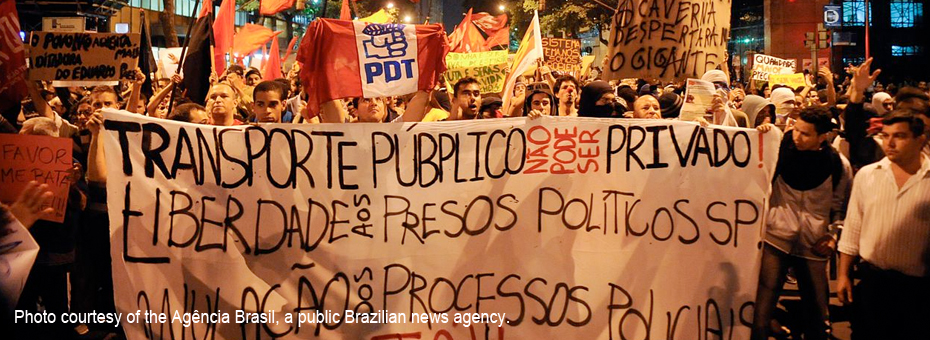The massive protests in Brazil in June surprised society and momentarily scared the government. As in many other countries, driven by the use of smart phones and social media, young demonstrators led the way demanding better public services, an end to corruption, and in this case, an end to overspending on the upcoming World Cup.
The tipping point was a protest against a public transportation (bus fare) tariff increase in the city of São Paulo that was crushed by police. This ignited a wave of protests across the rest of the country. Protesters expanded their focus beyond tariffs to the lack of quality public education and availability and quality of healthcare, extensive corruption made apparent by excessive expenditures in brand new football stadiums, violence, and insecure cities.
In response, the São Paulo local government, which is responsible for buses (whereas the state is responsible for the subway system and metropolitan area trains), decided to cancel the tariff increase of US $1.40 to US $1.50. The insignificance of the actual monetary amount—plus the fact that employees pay only a small fraction of it, employers pay most, students pay half, and the unemployed are exempt—is telling. The tariff issue was symbolic, representing a much broader issue. Longstanding, collective discontent with public sector policies quickly erupted nationwide. The government reacted by restructuring in other areas, postponing long-term bids in order to expose the numbers to the community and reducing other taxes and tariffs.
It’s worth noting that the bus system is a public concession operated by private companies while subways and trains are managed by the state. Some of the organizations that led the protests had demanded a reduction in private companies’ profits. The government inevitably arrived at a “catch 22” situation. In order to reduce the tariffs, the government would need to cut other public investments, lest private company profits should suffer.
What is missing in all of this is what we have learned throughout our many years in the private sector: cost reduction through waste elimination in the transportation system. If all stakeholders involved in the management of the transportation system could sit down together to understand the main processes involved and identify activities that could be reduced, simplified, or eliminated—many opportunities for improvement would arise and the quality of service would increase. We have witnessed this many times in our lean transformation efforts. Private companies would have an adequate return on their investments to continue making those investments required to continue making improvements. The bidding system would establish ongoing cost reductions through increased productivity and process improvement.
The demonstrations in June were the most significant we’ve seen in Brazil’s recent history. Politicians and government officials now have an opportunity to recover some lost credibility and focus on the right issues using the right approaches. However, current attempts to solve economic problems are headed in the wrong direction. More subsidies add complexity and artificiality to the system instead of making it more transparent and clear. Reducing costs by eliminating companies and agencies in order to free up resources for the transportation system doesn’t get to the heart of problem. Neither does a simple postponement of bidding process without changing its main assumptions: searching for the lowest bidding price and lack of criteria transparency. Just managing the numbers instead of focusing on process means we still don’t understand the operational system. And this only creates more problems.
Brazil wrestles with extreme social inequality. “Make more with less” is a mantra thousands of miles away from the transportation system and the public sector in general. “Spend more to achieve less” instead seems dominant, as astonishing as this sounds. A new, lean approach to the public transportation system could be successful and make way for essential learning that could then be applied to other areas of the public sector.
Customers of the system simply want to pay a reasonable amount for a good quality service. But political leaders and government officials seem so comfortable with antiquated practices that the distance between society’s needs and the state’s response in terms of an ability to provide adequate services will likely to continue to grow.
What experience do we in the lean community have when it comes to improving government? Is our struggle mainly related to Brazilian culture and politics? What can we all do to make governments be more aware of operational efficiency issues and work better for citizens?





